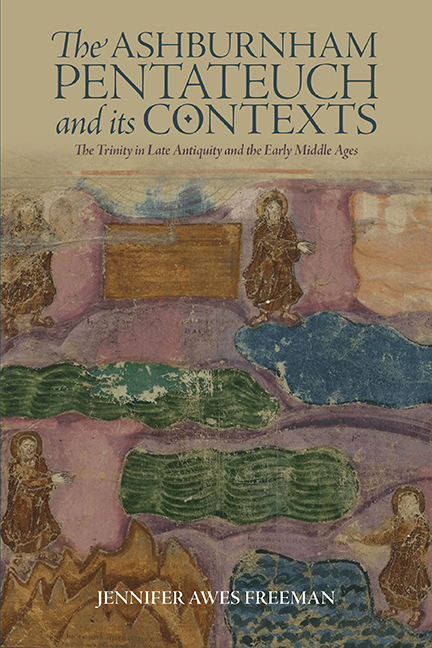Book contents
- Frontmatter
- Dedication
- Contents
- List of Illustrations
- List of Abbreviations
- Introduction: Losing and Finding the Ashburnham Pentateuch
- 1 Early Trinitarian Texts and Debates
- 2 The Trinity in Early Christian Images
- 3 Carolingian Conceptions of the Trinity
- 4 Carolingian Image Theory
- 5 The Carolingian Reception of the Ashburnham Pentateuch
- Conclusion: Possible Motivations for the Ashburnham Pentateuch Erasures
- Coda: The Afterlives of the Ashburnham Pentateuch
- Acknowledgments
- Bibliography
- Index
- ALREADY PUBLISHED
5 - The Carolingian Reception of the Ashburnham Pentateuch
Published online by Cambridge University Press: 26 May 2022
- Frontmatter
- Dedication
- Contents
- List of Illustrations
- List of Abbreviations
- Introduction: Losing and Finding the Ashburnham Pentateuch
- 1 Early Trinitarian Texts and Debates
- 2 The Trinity in Early Christian Images
- 3 Carolingian Conceptions of the Trinity
- 4 Carolingian Image Theory
- 5 The Carolingian Reception of the Ashburnham Pentateuch
- Conclusion: Possible Motivations for the Ashburnham Pentateuch Erasures
- Coda: The Afterlives of the Ashburnham Pentateuch
- Acknowledgments
- Bibliography
- Index
- ALREADY PUBLISHED
Summary
In the face of the Byzantine iconoclastic controversy and the Trinitarian debates closer to home, Carolingian theologians reaffirmed the indivisible unity of the Trinity, as well as the Godhead's cooperative, incorporeal presence in the act of Creation. These textual descriptions of the Trinity were reflected in visual depictions of Creation, which portrayed a single Creator – the Logos. Such images can rightly still be interpreted as Trinitarian, as Alcuin of York declared that, “Wherever in Holy Scripture we read, ‘God alone,’ this should not be taken as referring to any one person in the Holy Trinity, but to the entire Trinity.” Moreover, we have seen that Theodulf of Orléans, one of Charlemagne's theological advisers and a key figure in the Carolingian renovatio, maintained the essential difference between words and images in which words were the superior conveyer of spiritual truth and transformation. In his Opus Caroli Regis contra Synodum, written at the command of Charlemagne, Theodulf asserted a middle way between iconoclasm and the veneration of images; his position on religious images was reflected in the iconographical choices made in his commissioned Bibles and his apse mosaic at Germigny-des-Prés.
Two related questions underlie this study: how does an image formulate an argument differently than a text? And then, how is that argument affected when an image is changed or defaced? As an illustrated biblical codex, the Ashburnham Pentateuch can be understood as text, image, and object, and so an analysis of one of its images must take each aspect of its content and materiality into consideration. This chapter will first describe and analyze the erasures before moving on to locate them within the larger history of manuscript alterations. The concluding chapter of this book will evaluate several possible motivations for the erasures.
The erasures of the Ashburnham Pentateuch were executed in a political and theological climate that can be characterized by its efforts at reform and regulation, skepticism about religious images, and an emphasis on the unity and equality of the persons of the Trinity. Because consistency across a variety of texts was one of the major goals of the Carolingian reforms, it is perhaps not surprising that the content of a religious image be edited as well.
- Type
- Chapter
- Information
- The Ashburnham Pentateuch and its ContextsThe Trinity in Late Antiquity and the Early Middle Ages, pp. 147 - 163Publisher: Boydell & BrewerPrint publication year: 2022



